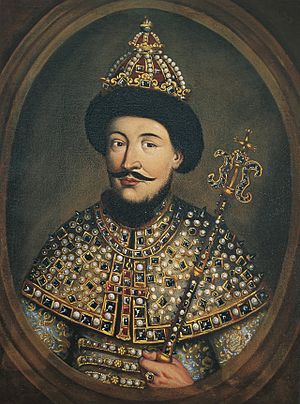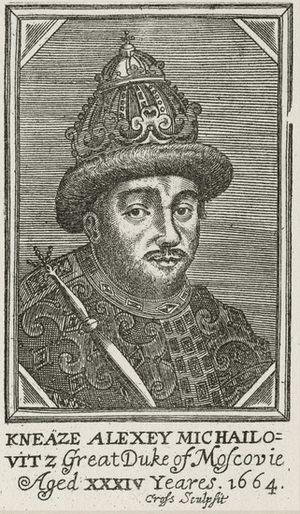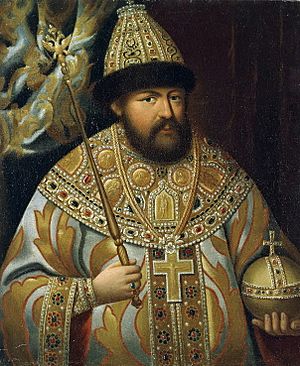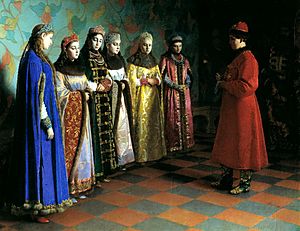Alexis of Russia facts for kids
Quick facts for kids Alexis I |
|||||
|---|---|---|---|---|---|
 |
|||||
| Tsar of Russia | |||||
| Reign | 12 July 1645 – 29 January 1676 | ||||
| Coronation | 28 September 1645 | ||||
| Predecessor | Michael | ||||
| Successor | Feodor III | ||||
| Born | 19 March 1629 Moscow, Russia |
||||
| Died | 29 January 1676 (aged 46) Moscow, Russia |
||||
| Burial | Archangel Cathedral | ||||
| Consort | Maria Ilyinichna Miloslavskaya Nataliya Kyrillovna Naryshkina |
||||
| Issue among others... |
Sofia Alexeevna Fyodor III Ivan V Peter I Natalya Alexeevna |
||||
|
|||||
| House | Romanov | ||||
| Father | Michael | ||||
| Mother | Eudoxia Streshneva | ||||
| Religion | Eastern Orthodox | ||||
Aleksey Mikhailovich (born March 19, 1629 – died January 29, 1676) was the tsar of Russia from 1645 until his death. During his time as ruler, Russia faced several challenges. These included wars with Poland and Sweden, a major split in the Russian Orthodox Church called the Raskol, and a large Cossack uprising led by Stenka Razin. Despite these difficulties, Russia grew significantly under his rule. By the time he died, Russia covered a huge area of almost 20 million square kilometers.
Contents
Becoming Tsar
Alexei was born in Moscow on March 19, 1629. He was the son of Tsar Michael and Eudoxia Streshneva. When his father died on July 12, 1645, the sixteen-year-old Alexei became the new tsar. He was crowned on September 28 in the Dormition Cathedral.
At first, Alexei was guided by his tutor, Boris Morozov. Morozov was a smart boyar (a high-ranking noble) who was open to new ideas from Western countries. Morozov tried to keep Russia peaceful with other countries. He made a truce with the Polish-Lithuanian Commonwealth and avoided problems with the Ottoman Empire. He also tried to limit the power of foreign traders in Russia.
In January 1648, Morozov arranged for Tsar Alexei to marry Maria Miloslavskaya. Morozov himself married Maria's sister. However, many people saw Morozov as corrupt. In May 1648, people in Moscow rebelled in what was called the Salt Riot. This riot happened because of high taxes, especially on salt. The young Tsar Alexei had to send Morozov away for a while.
Because of the public anger shown in the Salt Riot, Alexei created a new set of laws in 1649. This new legal code was called the Sobornoye Ulozhenie. It helped to organize laws and manage the country better.
Major Events During His Rule
Reforming the Army
In 1648, Tsar Alexei started to make big changes to the Russian army. He wanted to make it stronger and more like armies in Western Europe. He created many new types of regiments, like Reiters (cavalry), Soldiers, Dragoons, and Hussars. These new regiments became the main part of Russia's army.
To do this, Alexei hired many military experts from Europe. This was possible because the Thirty Years' War had just ended, meaning many skilled soldiers and officers were looking for work.
Dealing with Rebellions
Tsar Alexei faced many rebellions across Russia during his reign. After the Salt Riot in 1648, there were more uprisings in 1650 in the cities of Pskov and Novgorod. Alexei quickly stopped the Novgorod rebellion. However, Pskov was harder to control. Alexei eventually had to promise the city forgiveness if they surrendered.
By the 1660s, Russia's wars with Poland and Sweden were very expensive. To raise money, Alexei's government started making many copper coins in 1654. This caused the value of money to drop, leading to a serious financial crisis. In 1662, angry people in Moscow rebelled again in the Copper Riot. This rebellion was put down with force.
A major rebellion began in 1669 among the Cossacks in southern Russia, along the Don River. This uprising was led by Stenka Razin. Razin captured the city of Astrakhan and then took many towns along the Volga River from 1670 to 1671. His rebellion started to fail after he couldn't capture Simbirsk in October 1670. Razin was finally caught in April 1671 and was executed in Moscow.
Wars with Other Countries
War with Safavid Iran
In 1651, troops from the Safavid Empire (Persia) attacked Russian forts in the North Caucasus. This happened because Russia was building new forts near the border. The Safavids destroyed a Russian fort and forced its soldiers out. In 1653, Tsar Alexei decided to send a group of diplomats to Persia to find a peaceful solution. The Shah (ruler) of Persia, Abbas II, agreed to settle the conflict. He said the attack had happened without his full permission.
Wars with Poland and Sweden
In 1653, Poland was weak after a major uprising. This encouraged Alexei to try and take back old Russian lands that were part of Poland. In October 1653, a national meeting in Moscow approved the war. In April 1654, the Russian army began its campaign. They had great success, capturing many towns, including the important fortress of Smolensk.
The Ukrainian leader Bogdan Khmelnitsky asked Tsar Alexei for protection from the Poles. This led to the Treaty of Pereyaslav, which gave Russia control over the Cossack Hetmanate in Left-Bank Ukraine.
In 1655, Sweden suddenly invaded Poland. This event was known as the Deluge. Russia quickly took over many areas that the Swedes hadn't captured yet. Alexei wanted to take over all of Lithuania. However, Alexei and the King of Sweden started to argue over who should get what land. So, in May 1656, Alexei declared war on Sweden.
The war with Sweden didn't go as well as Russia hoped. They captured Dorpat, but many soldiers were lost trying to take Riga. Meanwhile, Poland became a stronger enemy again. Since Russia couldn't fight both at once, Alexei decided to make peace with Sweden first. In the Peace of Kardis (July 2, 1661), Russia gave back all the lands it had taken from Sweden.
The war with Poland continued for six more years. It finally ended with the Truce of Andrusovo on February 11, 1667. This truce was very important and lasted a long time. Russia gave back some lands to Poland, but kept important cities like Smolensk and Kiev, along with all the land east of the Dnieper River. This truce was largely thanks to Afanasy Ordin-Nashchokin, a skilled Russian diplomat. Later, Artamon Matveyev became Alexei's chief minister and had a good influence until the end of the Tsar's reign.
Church Split: The Old Believers
In 1653, Patriarch Nikon, the head of the Russian Orthodox Church, started some reforms. These changes aimed to make Russian church practices more like those of the Greek Church. For example, one change was to use three fingers instead of two when making the sign of the cross. These changes caused a lot of disagreement among church members.
Tsar Alexei supported Nikon until 1658, when Nikon left his position. In 1666, the tsar called a big meeting called the Great Moscow Synod. This meeting decided to officially remove Nikon from his position. It also decided to excommunicate (remove from the church) anyone who opposed the church reforms. Those who disagreed with the reforms broke away from the official church and formed the Old Believers movement.
Family and children
Alexei's first marriage was to Maria Miloslavskaya. They had a happy marriage and had thirteen children together (five sons and eight daughters) over 21 years. Maria died shortly after her thirteenth child was born. Four of their sons survived her: Alexei, Fyodor, Semyon, and Ivan. However, two of these sons, including the 15-year-old heir Alexei, died within six months of their mother.
Their children included:
- Tsarevich Dmitri Alexeevich (1648–1649); died as a baby.
- Tsarevna Yevdokia Alekseevna (1650–1712)
- Tsarevna Marfa Alekseyevna (1652–1707)
- Tsarevich Alexei Alexeevich (1654–1670); heir to the throne; died at age 15.
- Tsarevna Anna Alexeevna (1655–1659); died as a baby.
- Tsarevna Sofia Alexeevna (1657–1704); she later ruled Russia for her younger brothers from 1682–1689.
- Tsarevna Ekaterina Alexeevna (1658–1718)
- Tsarevna Maria Alexeevna (1660–1723)
- Fyodor III (1661–1682); he became Tsar after his father.
- Tsarevna Feodosia Alexeyevna (1662–1713)
- Tsarevich Simeon Alexeyevich (1665–1669); died as a baby.
- Ivan V (1666–1696); he ruled Russia together with his younger half-brother, Peter the Great.
- Tsarevna Yevdokia Alexeevna (1669–1669); died as a baby.
Alexei married a second time on February 1, 1671, to Nataliya Kyrillovna Naryshkina. She grew up in the home of Artamon Matveyev. Their children were:
- Peter I (1672–1725), known as "Peter the Great," who became a very famous Tsar of Russia.
- Tsarevna Natalya Alexeevna (1673–1716)
- Tsarevna Fyodora Alexeevna (1674–1677)
Images for kids
See also
 In Spanish: Alejo I de Rusia para niños
In Spanish: Alejo I de Rusia para niños





